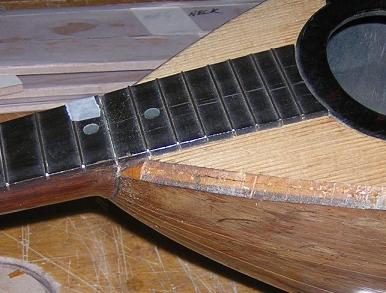|
Removing the top of a mandolin |
|||
|
For many of the repairs to the top of a mandolin, and some to the back as well, it is much easier with the top removed. This is usually a fairly simple procedure, especially if the top has partly lifted off already. Below is a step by step guide to top removal. |
|||
|
|
|
||
| A mandolin with damage to the interior struts, and a lack of good linings. The top must be removed to remedy these problems. | If the fingerboard is not to be taken off first, then it must be cut at fret 10, after removal of the 10th fret. Saw deeply enough to cut the f/b AND the top, which often extends up under the f/b. | ||
|
|
On this mandolin, the already damaged tulipwood edging must be removed before the top can be removed. It is usually not possible to get it off intact. |
|
With the edging removed, work a scraper into any open seams and twist gently. The hide glue will begin to crack open. |
|
|
The hardest spots are under the struts. Insert the scraper under the strut and twist firmly. |
|
Here the top and back are separated, and work can begin on any repairs. |
|
|
|
||
| With the more traditional lozenge edging, the edging should be taped up first. If you are lucky, it will come off intact, and pieces won't get lost or mixed up. | If there are no cracks, you will be forced to make some into the side seams. A particular problem is often the tail and heelblocks, which are often more strongly glued having greater surface areas than other glued points. | ||
|
|
|
||
|
After taping, the scraper is inserted into a
crack, and removal proceeds as above.
Work around the edges, making entry via cracks, and working towards any resistant sections, twisting the scraper gently as you go. |
Here part of the edging has come away cleanly, but other sections have remain glued and broken. This is fairly typical. These can be remove afterwards, and re-glued to the main sections before re-gluing... or the lining can be extended beyond the remaining edging to glue to the replaced top. | ||
|
|
If necessary, after removal of the top the
finger-board can removed later if it is thick enough. If the frets cut
thru the f/b, it will come off a fret at a time. It is possible to
rebuild these, but extremely fiddly.
Here the taped edging has remained almost completely intact..... |
|
... and the same top from beneath. It is also possible to see small areas that have been 'cut through' when the edging was fitted. This is a common fault, and may need remedying before refitting. |











